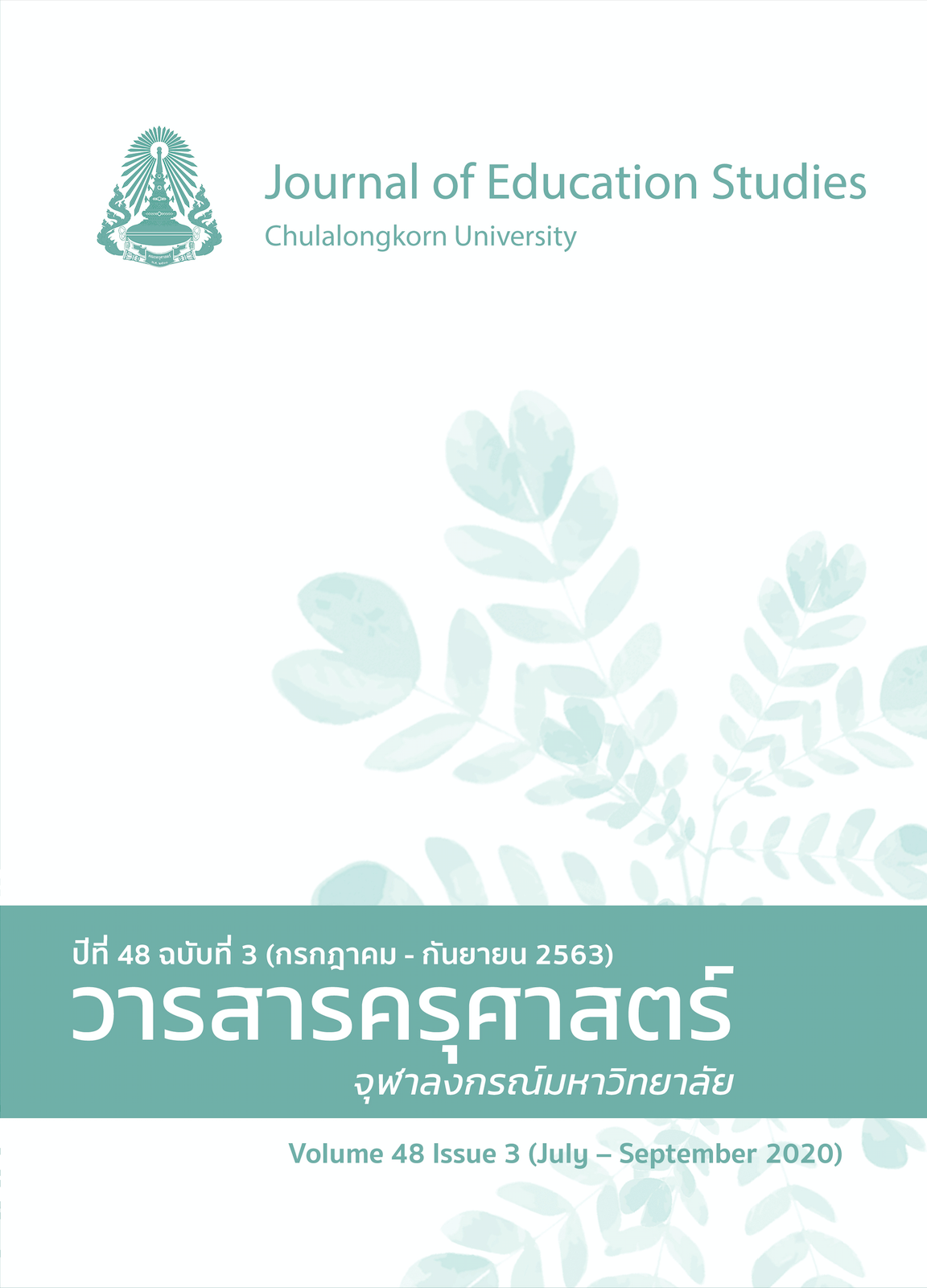Development of an Instructional Model based on Mathematization Approach and Realistic Mathematics Education to Enhance Mathematical Problem Solving and Reasoning Abilities of Lower-secondary School Students
Keywords:
mathematization, realistic mathematics education, mathematic problem solving ability, mathematical reasoningAbstract
The purposes of this research were to develop and study the effectiveness of an instructional model based on mathematization approach and realistic mathematics education to enhance mathematical problem solving and reasoning abilities. The research sample included 80 eighth grade students from 2 classrooms of Saipanyarangsit School, Pathum Thani Province. They were randomly assigned into 2 groups: the experimental group using the instructional model and the control group using the conventional approach. The research instruments were the test of mathematical problem solving ability and the test of mathematical reasoning ability. The data were analyzed by mean, standard deviation, and t-test.
The findings revealed that: 1) the developed instructional model consisted of 4 steps: connecting real experience to realistic mathematics, designing mathematical concepts, developing practical concepts, and reflecting to real life; 2) mathematical problem solving and reasoning abilities of the experimental group were higher than the control group at a significance level of .05; and 3) according to the qualitative data analysis, the experimental group’s behavior of problem solving and mathematical reasoning had a positive change.
References
ภาษาไทย
กรมวิชาการ กระทรวงศึกษาธิการ. (2545). คู่มือการจัดสาระการเรียนรู้กลุ่มคณิตศาสตร์. องค์การรับส่งสินค้าและครุภัณฑ์.
โครงการ PISA ประเทศไทย สถาบันส่งเสริมการสอนวิทยาศาสตร์และเทคโนโลยี [สสวท.]. (2546). การเรียนรู้เพื่อโลกวันพรุ่งนี้ รายงานการประเมินผลการเรียนรู้จาก PISA 2003. สสวท.
ฉวีวรรณ เศวตมาลย์. (2542). การแก้ปัญหา เอกสารประกอบการอบรมกิจกรรมคณิตศาสตร์. สาขาการมัธยมศึกษา (การสอนคณิตศาสตร์).
สถาบันทดสอบทางการศึกษาแห่งชาติ. (2560). เอกสารรายงานผลการประเมินผลสัมฤทธิ์ทางการเรียนระดับชาติ. www.niets.or.th
สถาบันส่งเสริมการสอนวิทยาศาสตร์และเทคโนโลยี [สสวท.]. (2545). มาตรฐานครูคณิตศาสตร์. คุรุสภาลาดพร้าว.
สถาบันส่งเสริมการสอนวิทยาศาสตร์และเทคโนโลยี [สสวท.]. (2547). การให้เหตุผลในวิชาคณิตศาสตร์. เอส.พี.เอ็น.
สถาบันส่งเสริมการสอนวิทยาศาสตร์และเทคโนโลยี [สสวท.]. (2555). ทักษะและกระบวนการทางคณิตศาสตร์ (พิมพ์ครั้งที่ 3). 3-คิว มีเดีย.
สมเดช บุญประจักษ์. (2543). การแก้ปัญหา. สถาบันราชภัฎพระนคร.
สิริพร ทิพย์คง. (2551). เป้าหมายของการเรียนคณิตศาสตร์. วารสารคณิตศาสตร์, 53(599-601), 12-19.
สุนีย์ คล้ายนิล, ปรีชาญ เดชศรี, และ อัมพลิกา ประโมจนีย์. (2546). สมรรถนะการแก้ปัญหาสำหรับโลกวันพรุ่งนี้. สสวท.
สำนักงานทดสอบทางการศึกษา กรมวิชาการ กระทรวงศึกษาธิการ. (2546). กรอบแนวคิด และแนวทางการประเมินผลด้วยทางเลือกใหม่ ตามหลักสูตรการศึกษาขั้นพื้นฐาน พุทธศักราช 2544 กลุ่มสาระการเรียนรู้คณิตศาสตร์. คุรุสภาลาดพร้าว.
อัมพร ม้าคนอง. (2554). ทักษะและกระบวนการทางคณิตศาสตร์: การพัฒนาเพื่อพัฒนาการ (พิมพ์ครั้งที่ 2). โรงพิมพ์แห่งจุฬาลงกรณ์มหาวิทยาลัย.
ภาษาอังกฤษ
Alice, F. A., & Shirel, Y. F. (1999). Mathematical reasoning during small-group problem solving (pp. 115-126). In Developing mathematical reasoning in grades K-12. National Council of Teachers of Mathematics.
Baroody, A. J. (1993). Problem solving, reasoning, and communicating, K-8: Helping children think mathematically. Macmillan.
Bell, H. F. (1981). Teaching and learning mathematics (in secondary school). Wm. C. Brown.
Dickinson, P., Eade, F., Gough, S., & Hough, S. (2010). Using realistic mathematics education with low to middle attaining pupils in secondary schools. Proceedings of the British Congress for Mathematics Education, 5(1), 34-46. https://www.researchgate.net/profile/Frank_Eade/publication/266487229_Using_Realistic_Mathematics_Education_with_low_to_middle_attaining_pupils_in_secondary_schools/links/54b7bdb70cf2bd04be33c4e0.pdf
Fauzan, A., Slettenhaar, D, & Plomp, T. (2002). Traditional mathematics education vs. realistic mathematics education: Hoping for changes. In Proceedings of the 3rd international mathematics education and society conference (pp. 1-4). CiteSeerX. http://citeseerx.ist.psu.edu/viewdoc/download?doi=10.1.1.470.6981&rep=rep1&type=pdf
Good, C. V. (1973). Directionary of education New York. McGraw-Hill.
Gravemeijer, K., & Terwel, J. (2000). Hans Freudenthal: A mathematician on didactics and curriculum theory. Journal of Curriculum Studies, 32(6), 777-796.
Greer, B. (1997). Modeling reality in mathematics classrooms: The case of word problems, learning and instructions, 7(4), 293-307.
Grigoras, R. (2008). Modelling in environments without numbers - A case study. http://ife.ens-lyon.fr/publications/edition-electronique/cerme6/wg11-17-grigoras.pdf
Hogan, M., & Alejandre, S. (2010). Problem solving – it has to begin with noticing and wondering. CMC ComMuniCator, Journal of the California Mathematics Council, 35(2), 31-33.
Kennady, L. M., & Tipp, S. (1997). Guiding children’s learning of mathematics (4th ed.). Wadsworth.
Lappan, G., & Schram, P. W. (1989). Communication and reasoning: Critical dimensions of sense making in mathematics. In New directions for elementary school mathematics 1989 yearbook (pp. 14-30). NCTM.
Meyer, M. R. (2001). Representation in realistic mathematics education. In A. A. Cuoco, & F. R. Curcio (Eds.), The roles of representation in school mathematics (pp. 238-250). NCTM.
National Council of Teachers of Mathematics [NCTM]. (1989). Curriculum and evaluation standards for school mathematics. NCTM.
National Council of Teachers of Mathematics [NCTM]. (2000). Principles and standards for school mathematics. NCTM.
Organization for Economic Co-operation and Development [OECD]. (1999). Measuring student knowledge and skills: A new framework for assessment. OECD Publications.
Polya, G. (1973). How to solve it: A new aspect of mathematical method (2nd ed.). Princeton University Press.
Polya, G. (1980). On solving mathematical problems in high school. In S. Krulik & R. E. Reys (Eds.), Problem solving in school mathematics (1980 Yearbook). The National Council of Teachers of Mathematics.
Van den Heuvel-Panhuizen, M. (2000). Mathematics education in the Netherland: A guided tour. Utrecht University. http://www.fi.uu.nl/en/rme/TOURdef+ref.pdf
Wilson, J. W., Fernandez, M. L., & Hadaway, N. (1993). Mathematical problem solving. In P. S. Wilson (Ed.), Research ideas for the classroom: High school mathematics (pp. 57-77). Macmillian.
Yoon, C. (2009). Modeling the height of the antiderivative. Mathematics Education Research Group of Australasia. http://www.merga.net.au/documents/Yoon_RP09.pdf




